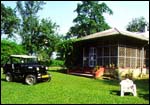

|
|
|
|
| HOME | TRAVEL | TRAVELOG | |||
| September 9, 1997 |
 A Bokaghat Break ... a holiday on an Assam tea plantation
Sanjay Singh Badnor
After breakfast the next morning I was ready to do a bit of exploring. The Behora Tea Garden, I discovered was a sprawling estate that covering a huge tract of roughly 670 hectares. Owned by MacNeil and Magors, one of the most reputed Indian tea companies, the estate apparently produced some of the finest teas in the world and had a few awards to show for it. Relaxing later on the airy veranda of Dushyant's bungalow, with Rusty, the adorable, resident German Shepherd for company, I was beginning to enjoy the wonderful atmosphere of Tea Country... an atmosphere that is yet another legacy of our former colonial rulers. Three full time malis tended the immaculately landscaped garden, which was bordered by hibiscus hedges. Neat rows of begonia were interspersed by exotic flowering bushes of ixora. And patches of flaming canna lilies added colour to the obsessively neat garden, surrounded by a field of wild Guatemala grass. Behind the bungalow a vegetable garden flourished. And fruit-bearing trees -- jackfruit, litchis and the citrus tenga -- stood tall along the border of the garden. Sitting on the veranda and admiring my graceful environs, poetry came to mind. "Hail, drink of life! How justly should our lyres respond the praises which thy power inspires! Thy charms alone can equal thoughts infuse! Be thou my theme, my nectar, and my muse."... lines from a poem on tea, penned by Peter Antoine Motteaux in 1712. Tannin was going to my head. It is traditionally believed that China was the first tea drinking nation. However today Indian tea is undoubtedly the best in the world. Teas from Darjeeling, Dooars, Terai, Tripura, Arunachal, Kangra valley, the Nilgiris, High Range, Anamalais, Karnataka, Orissa, Dehra Dun and of course Assam, all have their own distinctive characteristics and tastes, due to the variance in agro-climates. No other country can boast of such a vast variety of tea (apart from quantity; India produces about 800 million kilos of tea every year). And no other tea growing region anywhere in the world can match the brightness, pungency, strength and taste of the famed Assam CTC tea. They say that a quality blend is incomplete, without that crucial and substantial percentage of Assam tea.
I pay a visit to the factory where my host, Assistant Manager Dushyant takes me on a guided tour. Tea manufacturing is a fairly complex process. The Behora Tea Garden, I learnt, during peak season manufactures anywhere between 30,000 and 50,000 kg of tea per day. The Golden Flowery Broken Orange Pekoe or GF BOP, as it is called for short, is a superior quality tea and is a brand that finds its way into the most orthodox European markets. I took a few days off from GF BOP and Co to take an obligatory safari of the Kaziranga game reserve. I returned a wee bit disappointed at not having sighted the elusive one horned Indian rhinoceros. The park though was incredibly beautiful and the Brahmaputra river meanders along the park's borders. Elephants can be seen in large numbers, as well as a wide variety of exotic birds and other smaller animals. However little did I expect that upon my return to the Behora Tea Garden I would encounter my first wild elephant at alarmingly close quarters. Browsing through a few magazines one evening, I was suddenly startled by a huge shadow. To my utmost horror and surprise, I discovered a huge wild tusker standing in the middle of the lawn, barely a few yards away... a bit too close for comfort. The flimsy wire mesh that enclosed the verandah was all that lay between the elephant and I . Better sense prevailed and I did not panic. I just sat staring wide-eyed waiting for the elephant's next move. Visions of the BPL television commercial -- the Emperor -- raced through my mind and I realised how easy it was for a tusker to simply break into a bungalow and walk right into its living room. But the tusker, I realised was fortunately not in a destructive mood. In fact it was hungry and having spotted a grapefruit tree, he soon nonchalantly stomped off, trumpeting, to devour its juicy fruit. Later when Dushyant, my host, returned he explained that this was not an abnormal occurrence. He recounted another hair-raising anecdote. A hungry elephant was known to periodically waylay travellers on the Numaligarh-Dimapur road, that passes through the Garampani forest. He would stop the vehicle by obstructing the road and would literally force his trunk into the car searching for foodstuff.
And who do you think would be its best narrators? The tea planters of course, for whom each day was a new adventure. My vacation at a tea garden was drawing to a close. Life on a plantation was charmingly slow. But also monotonous. There was luxury and grace and, of course, space. However the regimental pace can well turn boring for the tea planter. But for those who love the outdoors a tea estate holiday is a treat. Photographs by Sanjay Singh Badnor
|
|
|
|
|
HOME |
NEWS |
BUSINESS |
CRICKET |
MOVIES |
CHAT
INFOTECH | TRAVEL | LIFE/STYLE | FREEDOM | FEEDBACK |
|